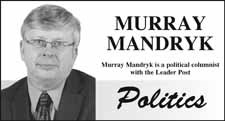Falling resource revenue and rising debt in the mid-year 2012-13 budget update will be unnerving for some of you that have been around for awhile.
This was the scenario during the former Progressive Conservative Premier Grant Devine's government in the 1980s.
And the outcome was particularly devastating for rural Saskatchewan.
Low resource revenue combined with the disastrous financing of that administration resulted a billion dollars in additional debt during each of those years in the 1980s. When the NDP government came into office in 1991, they were forced to make some harsh choices.
One can argue until the cows come home as to whether closing 52 rural hospitals or tearing up the GRIP contracts with farmers or virtually abandoning maintenance or rural highways were the right choices. Harder to debate, however, is the reality that they were caused by a government saddling us with too much debt as resource revenue plummeted.
So one might be somewhat forgiven for being a little nervous over the news that Finance Minister Ken Krawetz's budget this year will add a billion dollars and that the province will not earn about $600 million less in oil, gas, potash and Crown land lease sales than the March budget initially predicted.
It sounds all too similar to what got us into so much trouble in the 1980s.
But while there may be similarities to what went on 30 years ago that led to so much trouble for rural Saskatchewan and the rest of the province, there are also some very big, important differences.
First and foremost, Krawetz's budget is again balanced - something that no Devine-era finance minister was able to accomplish.
It might only be a modest $12-million surplus, but that's actually a pretty impressive feat, given the aforementioned $60-million drop in resource revenues.
Credit should go to the entire Saskatchewan Party cabinet for actually finding decreases in 12 of 31 line departments, while coming in on target in 13 others.
Second, it is not particularly comforting to see overall provincial debt rapidly climbing upward into the stratosphere of $9.55 billion - an additional billion dollars in one year. Those who witnessed public debt increase from $3 billion when the Devine government entered office in 1982 to $13 billion nearly 10 years later when the Progressive Conservatives left office in 1991 will be especially unnerved by that figure.
And it is annoying is to see SaskPower asking for an additional $120 million in borrowing in this budget update. A year earlier, SaskPower provided government with a special $120 million to allow it to balance the books before the election.
But let us understand that this debt is all on the Crown side.
Obviously, no debt is good, but large utilities in need of upgrades always need to borrow money for infrastructure improvements. And some of that money they now borrow will be recovered in the utility rates we pay.
This is quite different than the Devine's debt of the 1980s that was also caused by accumulated deficits - money owing to run government operations, that we are still paying back to the New York banks.
Thirty years after Devine's first deficit budget, that accumulated PC government debt is still $3.8 billion. That's $3 billion less than it was, but it is still costing Saskatchewan taxpayers $395 million in annual interest charges.
Finally, while falling resource revenue is never good in a resource-based province like ours, it's important to note that $95-a-barrel oil offers little reason to complain.
Clearly, the provincial government has to do a better job of estimating potash revenue. Its budget six months ago overestimated potash revenue by $240 million.
But given that it wasn't so long ago that we didn't make $240 million in potash revenue in an entire year, some perspective is needed.
And if nothing else, the mess left behind in the 1980s has given us a lot oft perspective.
Murray Mandryk has been covering provincial politics for over 15 years.




